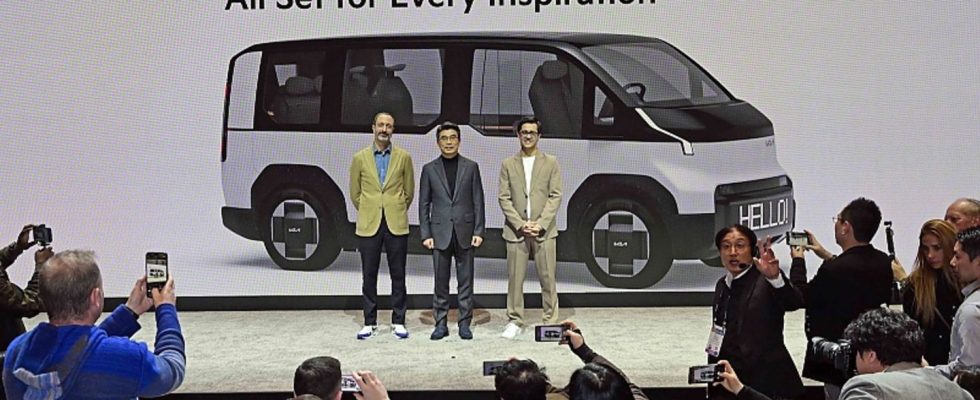Auto International: Auto nations China versus South Korea
Each in their own way
Kia at CES 2024 Las Vegas
© press-inform – the press office
More and more Chinese car manufacturers are flocking to the European market, which is why some experts are already proclaiming the downfall of the automotive West. There is a country competition that will have an impact on almost all world markets for years to come. A heated duel between China and South Korea has long since broken out. For many people, South Korea comes across as much more positive than China. However, the goals are very similar.
Brands like BYD, Geely and Saic would like to become the largest car manufacturer in the world in the medium term. Toyota still leads the sales statistics with more than eleven million vehicles, ahead of Volkswagen (9.2 million). Over the years, Hyundai has fought its way up from sixth and fifth place to third place. The gap to the numerous Volkswagen Group brands has recently become smaller and smaller. Hyundai has now clearly exceeded the seven million mark, while the large group from Wolfsburg, which once targeted more than ten million vehicles, can now look backwards rather than forwards to Toyota. Lexus, Toyota and Daihatsu have escaped unchallenged despite manageable electric trends. There is still some room for improvement behind the leading trio, while the largest Chinese car manufacturer Saic, with its broad brand portfolio, has now left Ford behind and is fighting its way towards General Motors and Stellantis.
The Chinese Saic Group includes a very diverse portfolio of passenger cars and commercial vehicles with MG, Maxus, Roewe, Yanfeng or the Saic-VW or Saic-GM collaborations. The situation is very similar with the direct Chinese competitors, who have often concentrated on electric or at least electrified drives without the legacy of combustion engines. Geely, BYD, Chery and Great Wall mostly have a variety of brands on the domestic car market, but many of the young labels have not yet exported anything abroad. Little by little, the sub-brands, which are often hastily sprung up without a real identity, first have to find each other and then it is checked whether they can be easily adapted for individual markets such as the United States, Japan, Germany, Great Britain, Brazil or France. Some, but by no means all, of the Chinese brands already operating in Europe rely solely on electric motors, which simplifies positioning and cost structures. Depending on the region, some models in China itself, South America or Africa are still offered as combustion engine versions.
The Hyundai Group wants to become the world number one within this decade and thus leave Toyota and Volkswagen, which are ahead of it, behind. The Koreans are even more focused on fewer brands than the planning-secure Japanese with their award-winning production facilities, but position them much more clearly in terms of brand identity and design than most Chinese competitors. This is not surprising because the two main brands Hyundai and Kia are easier to control with the luxury offshoot Genesis than a confusing brand conglomerate like Volkswagen or Stellantis has to juggle. While Genesis relies uncompromisingly on the design and electric drives of the future in order to compete against Audi, BMW and Mercedes, Hyundai presents itself as more down-to-earth and Kia can sometimes be a little bolder with models and designs. The brand image of all three has been significantly sharpened since 2018/2019; Even though Genesis in particular is still struggling to be perceived as an established competitor to the three major German premium manufacturers or an opponent of Volvo, Cadillac or Jaguar Land Rover.
Geely is ahead here precisely because of its intelligently purchased and revitalized new brands such as Volvo, Polestar, Smart and Lotus. Historically, they are sometimes assigned to the particularly profitable premium segment, but they have fallen asleep and now have to be filled with ideas, products and technologies. This is easier, especially with an intelligent group or platform strategy, than establishing the brand in the minds of heterogeneous customers over a long period of time by spending billions. How difficult this can be cannot only be seen at Genesis, where the products are always competitive compared to the competition from Germany, the USA or Italy, but there is simply a lack of awareness. The same fate not only affects electric newcomers such as Nio or the rapidly emerging models from BYD, but also a newcomer, the Li Auto, which is still completely unknown in Europe. But similar to a new electric brand like MG or Lotus, Li Xiang is not lacking in the models themselves, which hardly have to hide from the established manufacturers from Europe or the USA. But without a well-known brand name, you don’t have to try in the particularly competitive markets and the higher the segment, the greater the inhibitions to switch. Here the Hyundai Group is a few steps ahead with its brand triumvirate and has very big plans for the coming years – just like its direct competitors from China.

